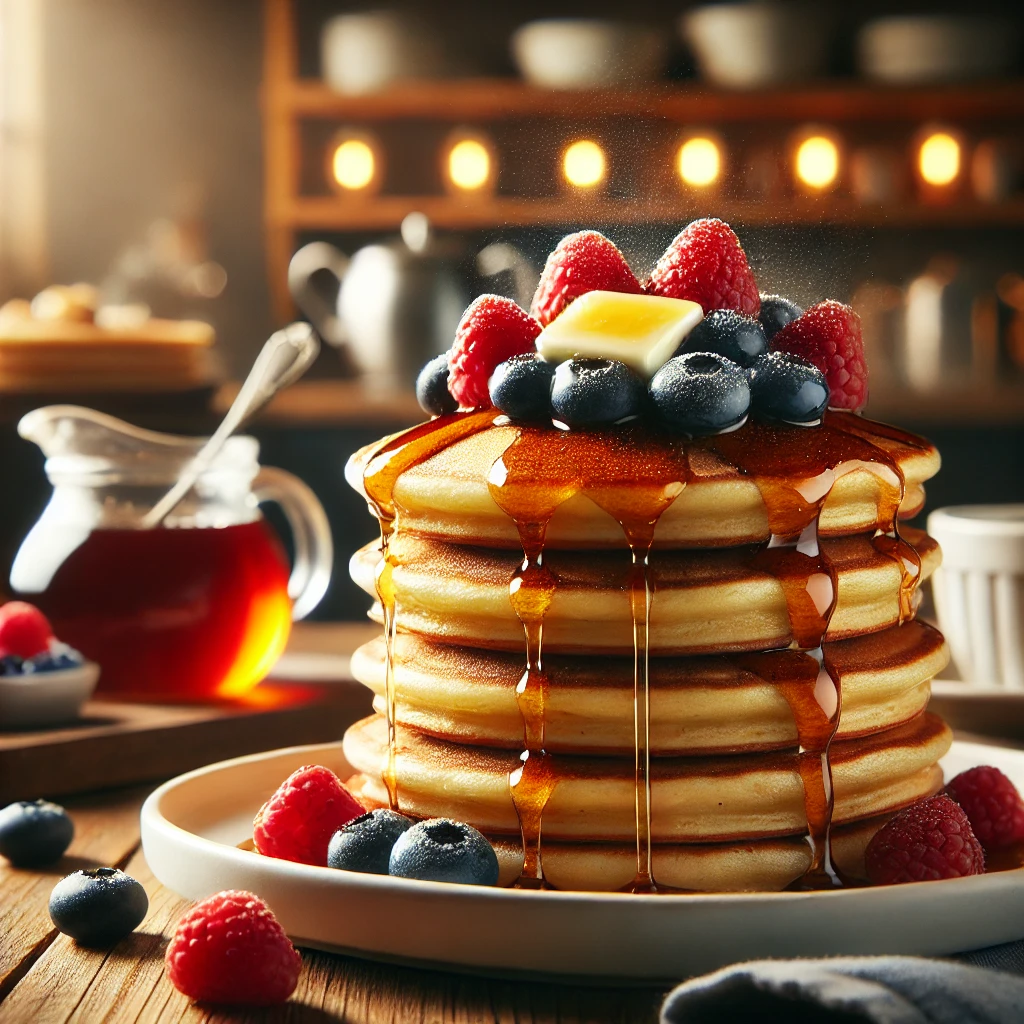There’s something magical about a warm stack of pancakes. Whether enjoyed as a comforting breakfast, a delightful brunch, or even a late-night treat, pancakes are an irresistible classic. The beauty of pancakes lies in their simplicity; they require only a few pantry staples and can be customized in endless ways.
In this guide, we will walk you through the best pancake recipe, tips for achieving the perfect texture, common mistakes to avoid, and variations to suit your preferences. By the end, you’ll be a pancake expert, ready to impress family and friends with your delicious creations.
Ingredients for the Perfect Pancakes
To make a batch of classic, fluffy pancakes, you will need:
Dry Ingredients:
- 2 cups (250g) all-purpose flour
- 2 tablespoons granulated sugar
- 1 tablespoon baking powder
- ½ teaspoon salt
Wet Ingredients:
- 1 ¾ cups (420ml) milk (whole milk preferred)
- 2 large eggs
- ¼ cup (60ml) unsalted butter, melted
- 1 teaspoon vanilla extract
Step-by-Step Pancake Preparation
1. Preparing the Batter
In a large mixing bowl, whisk together the dry ingredients: flour, sugar, baking powder, and salt. This ensures an even distribution of ingredients, preventing clumps.
In a separate bowl, whisk the eggs, then add the milk, melted butter, and vanilla extract. Stir well until combined.
Slowly pour the wet ingredients into the dry mixture, gently whisking. Do not overmix—the batter should be slightly lumpy. Overmixing will result in dense, tough pancakes.
2. Preheating the Pan
Heat a non-stick skillet or griddle over medium-low heat. Lightly grease the pan with butter or cooking spray. A properly heated pan ensures even cooking and a golden-brown surface.
3. Cooking the Pancakes
Using a ladle or measuring cup, pour about ¼ cup of batter onto the pan for each pancake. Cook for 2-3 minutes, until bubbles form on the surface and the edges look set. Flip the pancake and cook for another 1-2 minutes until golden brown. Repeat with the remaining batter.
4. Keeping Pancakes Warm
Place cooked pancakes on a baking sheet in a 200°F (93°C) oven to keep them warm while you finish cooking the batch.
Tips for Fluffy Pancakes
- Use Fresh Baking Powder: Baking powder is crucial for lift. If it’s expired, your pancakes may turn out flat.
- Don’t Overmix: Lumps in the batter are fine. Overmixing creates gluten, resulting in chewy rather than fluffy pancakes.
- Let the Batter Rest: Allowing the batter to rest for 5-10 minutes helps the flour absorb moisture, leading to a better texture.
- Medium-Low Heat is Key: Cooking pancakes too quickly results in a burnt outside and undercooked inside.
- Flip Only Once: Flipping pancakes multiple times can deflate them and make them tough.
Pancake Variations and Add-Ins
While classic pancakes are fantastic on their own, there are numerous ways to elevate them. Here are some delicious variations:
1. Buttermilk Pancakes
Replace regular milk with buttermilk for extra tang and tenderness. The acidity in buttermilk reacts with baking powder, making pancakes even fluffier.
2. Chocolate Chip Pancakes
Add ½ cup of chocolate chips to the batter for a sweet and indulgent twist.
3. Blueberry Pancakes
Fold in ¾ cup of fresh or frozen blueberries for a fruity burst of flavor.
4. Banana Pancakes
Mash one ripe banana and mix it into the wet ingredients. This adds natural sweetness and moisture.
5. Protein Pancakes
For a high-protein version, substitute half of the flour with protein powder and add an extra egg.
6. Vegan Pancakes
Replace eggs with 2 tablespoons of ground flaxseeds mixed with 5 tablespoons of water. Use plant-based milk and coconut oil instead of butter.
Toppings and Syrups
The right toppings can take your pancakes from good to incredible. Here are some of the best options:
- Classic Maple Syrup: The timeless favorite, perfect for drizzling over warm pancakes.
- Whipped Cream: Adds a light, airy texture that pairs well with fruit.
- Fresh Berries: Strawberries, raspberries, or blueberries bring freshness and color.
- Nut Butter: Almond or peanut butter provides a creamy, nutty depth.
- Yogurt and Honey: A healthier alternative that still delivers sweetness and richness.
- Nutella and Sliced Bananas: A decadent, dessert-like treat.
Storing and Reheating Pancakes
Pancakes are best enjoyed fresh, but they can be stored for later use.
Storing:
- Refrigeration: Keep leftover pancakes in an airtight container in the fridge for up to 3 days.
- Freezing: Stack pancakes with parchment paper between them and store them in a freezer bag for up to 2 months.
Reheating:
- Microwave: Heat for 30-45 seconds.
- Oven: Place pancakes on a baking sheet and warm at 350°F (175°C) for 5-7 minutes.
- Toaster: Pop them in a toaster for a crispier texture.
Common Pancake Mistakes to Avoid
Even experienced cooks can run into pancake problems. Here’s how to avoid the most common mistakes:
- Batter Too Thick or Thin: If the batter is too thick, add a splash of milk. If too thin, add a bit more flour.
- Using High Heat: This leads to burnt pancakes with an uncooked center. Stick to medium-low heat.
- Flipping Too Early: Wait until bubbles form and the edges set before flipping.
- Overcrowding the Pan: Cooking too many pancakes at once lowers the temperature, leading to uneven cooking.
- Skipping the Grease: Even on non-stick pans, a little butter or oil ensures a crispy edge.
Conclusion
Making perfect pancakes is easy once you understand the key techniques and ingredients. Whether you stick to the classic recipe or experiment with fun variations, pancakes are a versatile and delightful dish that everyone loves. So grab your whisk, heat up your griddle, and start flipping some delicious, golden-brown pancakes today!
